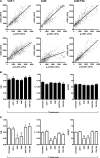Claudin association with CD81 defines hepatitis C virus entry
- PMID: 20375010
- PMCID: PMC2898367
- DOI: 10.1074/jbc.M110.104836
Claudin association with CD81 defines hepatitis C virus entry
Abstract
Viruses initiate infection by attaching to molecules or receptors at the cell surface. Hepatitis C virus (HCV) enters cells via a multistep process involving tetraspanin CD81, scavenger receptor class B member I, and the tight junction proteins Claudin-1 and Occludin. CD81 and scavenger receptor class B member I interact with HCV-encoded glycoproteins, suggesting an initial role in mediating virus attachment. In contrast, there are minimal data supporting Claudin-1 association with HCV particles, raising questions as to its role in the virus internalization process. In the present study we demonstrate a relationship between receptor active Claudins and their association and organization with CD81 at the plasma membrane by fluorescence resonance energy transfer and stoichiometric imaging methodologies. Mutation of residues 32 and 48 in the Claudin-1 first extracellular loop ablates CD81 association and HCV receptor activity. Furthermore, mutation of the same residues in the receptor-inactive Claudin-7 molecule enabled CD81 complex formation and virus entry, demonstrating an essential role for Claudin-CD81 complexes in HCV infection. Importantly, Claudin-1 associated with CD81 at the basolateral membrane of polarized HepG2 cells, whereas tight junction-associated pools of Claudin-1 demonstrated a minimal association with CD81. In summary, we demonstrate an essential role for Claudin-CD81 complexes in HCV infection and their localization at the basolateral surface of polarized hepatoma cells, consistent with virus entry into the liver via the sinusoidal blood and association with basal expressed forms of the receptors.
Figures






Similar articles
-
CD81 and claudin 1 coreceptor association: role in hepatitis C virus entry.J Virol. 2008 May;82(10):5007-20. doi: 10.1128/JVI.02286-07. Epub 2008 Mar 12. J Virol. 2008. PMID: 18337570 Free PMC article.
-
In silico directed mutagenesis identifies the CD81/claudin-1 hepatitis C virus receptor interface.Cell Microbiol. 2012 Dec;14(12):1892-903. doi: 10.1111/cmi.12008. Epub 2012 Sep 25. Cell Microbiol. 2012. PMID: 22897233 Free PMC article.
-
Hepatitis C virus induces CD81 and claudin-1 endocytosis.J Virol. 2012 Apr;86(8):4305-16. doi: 10.1128/JVI.06996-11. Epub 2012 Feb 8. J Virol. 2012. PMID: 22318146 Free PMC article.
-
Hepatitis C virus entry into host cells.Cell Mol Life Sci. 2008 Jan;65(1):100-12. doi: 10.1007/s00018-007-7291-8. Cell Mol Life Sci. 2008. PMID: 17914604 Free PMC article. Review.
-
Hepatitis C virus entry and the tetraspanin CD81.Biochem Soc Trans. 2011 Apr;39(2):532-6. doi: 10.1042/BST0390532. Biochem Soc Trans. 2011. PMID: 21428934 Review.
Cited by
-
Plasma Membrane Tetraspanin CD81 Complexes with Proprotein Convertase Subtilisin/Kexin Type 9 (PCSK9) and Low Density Lipoprotein Receptor (LDLR), and Its Levels Are Reduced by PCSK9.J Biol Chem. 2015 Sep 18;290(38):23385-400. doi: 10.1074/jbc.M115.642991. Epub 2015 Jul 20. J Biol Chem. 2015. PMID: 26195630 Free PMC article.
-
Interferon-α inducible protein 6 impairs EGFR activation by CD81 and inhibits hepatitis C virus infection.Sci Rep. 2015 Mar 11;5:9012. doi: 10.1038/srep09012. Sci Rep. 2015. PMID: 25757571 Free PMC article.
-
New Insights into the Understanding of Hepatitis C Virus Entry and Cell-to-Cell Transmission by Using the Ionophore Monensin A.J Virol. 2015 Aug;89(16):8346-64. doi: 10.1128/JVI.00192-15. Epub 2015 Jun 3. J Virol. 2015. PMID: 26041282 Free PMC article.
-
Rewiring Host Signaling: Hepatitis C Virus in Liver Pathogenesis.Cold Spring Harb Perspect Med. 2020 Jan 2;10(1):a037366. doi: 10.1101/cshperspect.a037366. Cold Spring Harb Perspect Med. 2020. PMID: 31501266 Free PMC article. Review.
-
Adaptive immunity to the hepatitis C virus.Adv Virus Res. 2010;78:43-86. doi: 10.1016/B978-0-12-385032-4.00002-1. Adv Virus Res. 2010. PMID: 21040831 Free PMC article. Review.
References
MeSH terms
Substances
Grants and funding
LinkOut - more resources
Full Text Sources
Other Literature Sources
Medical
Molecular Biology Databases

